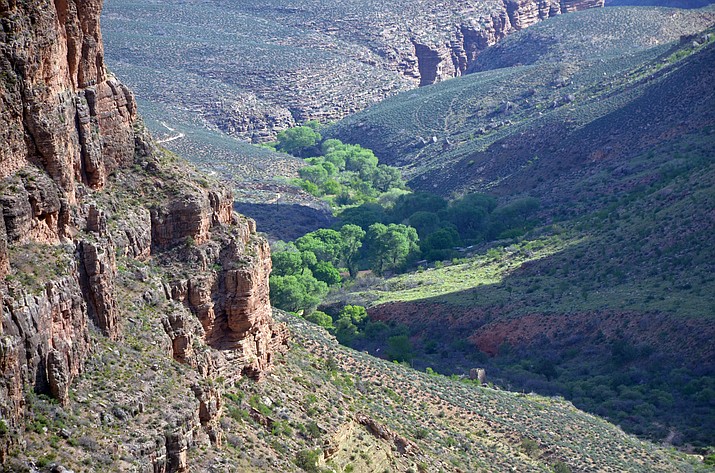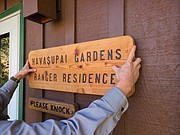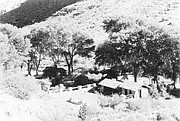Restoring a Canyon legacy: Grand Canyon’s Indian Garden officially renamed Havasupai Garden
After more than two years of consideration and consultation with the Havasupai Tribe, Grand Canyon National Park has officially changed the name of Indian Garden to Havasupai Garden, honoring the tribe’s legacy of living in and farming the green oasis along Bright Angel Trail for many generations. (Photo/NPS)
GRAND CANYON -- The U.S. Board of Geographic Names voted unanimously (19-0) earlier this month in favor of the formal request submitted by the National Park Service on behalf of the Havasupai Tribe to change the name of Indian Garden to Havasupai Gardens.
Earlier this year, the Havasupai Tribe passed Resolution 29-21 which provided a formal request to the National Park
Service to change the name. Havasupai Gardens is along the Bright Angel Trail and is a frequent stop for day hikers and backpackers exploring the backcountry of Grand Canyon.
Originally called Ha’a Gyoh, the National Park Service (NPS) instituted policies that forced the Havasupai people from Ha’a Gyoh and in 1928, the last Havasupai resident, Captain Burro, was forcibly removed. Havasupai people continued to live and work within Grand Canyon National Park, despite the forced removal from the inner canyon.
“Park employees kept noticing a Native man walking up and down the canyon walls to Indian Garden, and they began to call him Billy Burro. After all, he could hike up and down those walls just like a mule,” said Ophelia Watahomigie-Corliss, a member of the Havasupai Tribe and former Council member. “This man and his family were pushed out of Indian Garden, forced to leave the land they had farmed for generations so the national park could
make it theirs. Billy Burro’s daily trail was turned into what is most of Bright Angel Trail today.”
“The eviction of Havasupai residents from Ha’a Gyoh coupled with the offensive name, Indian Garden, has had detrimental and lasting impacts on the Havasupai families that lived there and their descendants,” said Chairman Thomas Siyuja, Sr. “Every year, approximately 100,000 people visit the area while hiking the Bright Angel Trail, largely unaware of this history. The renaming of this sacred place to Havasupai Gardens will finally right that wrong.”
Traditionally, the Havasupai people used many different areas of the Grand Canyon – they hunted and grazed along the rim and farmed at the former Indian Garden while maintaining a base camp near present-day Supai.
These seasonal migrations, however, were interrupted when the tribe was confined to a reservation in 1880 under political pressure from miners and business men looking to profit from their ancestral lands. Located in and around Cataract Canyon, the 38,000 acres of reservation land was eventually whittled down to just over 500 acres.
Because the arrival of the railroad and the construction of a road to the South Rim brought increasing numbers of tourists and fortune-hunters to the Grand Canyon, the forerunner to the NPS decided that Native Americans living within the newly-formed national monument was bad for business. In some cases, homes and crops were burned to ensure the area’s Havasupai inhabitants had nothing to return to.
“The Grand Canyon National Park team was proud to work alongside the Havasupai Tribal Council in our joint effort to rename this culturally significant location at the Grand Canyon,” said Superintendent Ed Keable. “The Havasupai people have actively occupied this area since time immemorial, before the land’s designation as a National Park and until the park forcibly removed them in 1926. This renaming is long overdue. It is a measure of respect for the undue hardship imposed by the park on the Havasupai people.”
“The people of the Havasupai Tribe have always called the vast Grand Canyon and the plateau lands south of it our homeland,” said Chairman Siyuja. “The Creator made the Havasupai People the guardians of the Grand Canyon, and this is a role that we take very seriously. We are a small tribe. But our voices and our spirits are large.”
The Burro family changed their name to Tilousi, which means “storyteller.” And for generations, the Burro-Tilousi family have fought to protect the history and culture of the Havasupai people.
“As a descendent of the Burro-Tilousi family I am glad to see that we will always remember and honor the true history of my family’s forced relocation due to the development of the Grand Canyon National Park,” said Carletta Tilousi, a member of the Havasupai Tribe and former Council member. “For that reason, honoring our ancestors and remembering our history is also very important to the Havasupai people. I hope this historic action will help other Tribes take similar steps and reclaim lands back by changing place names for historic and cultural preservation purposes.”
Efforts are already underway to update signage, website and other materials with the new name. The Havasupai Tribe and NPS are currently planning a rededication ceremony in early Spring 2023.
Relocation of water intake for pipeline project impacts
- Driver identified in fatal accident on Perkinsville Road Sept. 19
- Latest Tik Tok challenges causing problems for Williams Unified School District
- Search at Grand Canyon turns up remains of person missing since 2015
- Plane wreckage and human remains found in Grand Canyon National Park
- Pumpkin Patch Train departs Williams starting Oct. 5
- Update: Man missing in Grand Canyon National Park hike found alive
- Receding water levels at Lake Powell reveal missing car and driver
- Man sentenced for attack on camper at Perkinsville
- Column: Lumber prices expected to stay high through 2022
- Elk rut season in Grand Canyon: What you need to know
SUBMIT FEEDBACK
Click Below to:








